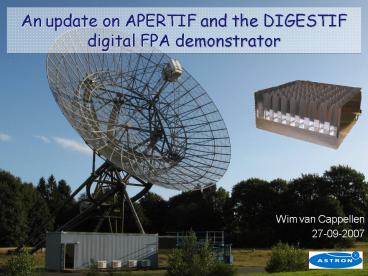Insert subject here - PowerPoint PPT Presentation
1 / 23
Title:
Insert subject here
Description:
DIGESTIF Characteristics. Frequency range 1.0 1.7 GHz. Array size ... First light: Driftscan Virgo A. 0.2s integration per point, 20 MHz bandwidth, 1420 MHz ... – PowerPoint PPT presentation
Number of Views:43
Avg rating:3.0/5.0
Title: Insert subject here
1
An update on APERTIF and the DIGESTIF digital FPA
demonstrator
- Wim van Cappellen
- 27-09-2007
2
APERTIF Overview
- Technically, APERTIF aims to increase the FoV and
bandwidth of the WSRT by using Focal Plane Arrays - Optimum use of mechanical infrastructure
- Operational in 2010
- All digital beamforming
3
Status APERTIF
- RD focuses on the (current) highest risks of FPA
technology - Sensitivity Ae/Tsys
- Dynamic range
- Calibration, stability, wide-field imaging
- Two complementary parallel activities
- Extensive simulation effort
- FPA test platform on the WSRT
4
Activities
- Efficient electromagnetic modeling of large
arrays - MoM, CBF in combination with ACA
- System analysis
- System noise and sensitivity calculation
- Calibration and wide-field imaging
- Stability, dynamic range
- Optimization
- How to choose weights for different scenarios
- (high sensitivity / low sidelobes / etc)
- Design
- Wideband arrays, room temperature LNAs
- Digital hardware leans strongly on LOFAR
- Demonstrator DIGESTIF
- DIGital Early Stage Tile In Focus
5
APERTIF front-end development planning
FE0
APERTIF
DIGESTIF integrated
RD phase
DIGESTIF stand-alone
Proof of concept Basic architecture
DIGESTIF integrated
Demonstrator architecture Tsys 100 50
K Sensitivity, Calibration, Imaging, Stability
FE0 development
Roll-out
Final architecture Tsys 50 K
2005
2006
2007
2008
2009
2010
6
DIGESTIF
- DIGital Early Stage Tile In Focus
- A digital FPA demonstrator in one of the WSRT
dishes to test and evaluate sensitivity,
calibration and imaging
7
DIGESTIF Characteristics
- Frequency range 1.0 1.7 GHz
- Array size 80 x 80 cm
- Dual linear polarization (vivaldi elements)
- Number of elements 8 x 7 x 2 112
- Instantaneous bandwidth 30 MHz
- Number of receivers 60
- Observation time max 6.7 seconds per measurement
- System temperature 100 K
- Dish diameter 25 m
- Raw data storage enormous flexibility since the
weighting factors are applied afterwards. This
allows optimisation of the beamformer weights in
software without re-measuring!
8
Array in the focusbox
9
Dual polarised Vivaldi array
10
Down Conversion Unit
- Convert input band (1.0 1.7 GHz) to
- LOFAR band (40 80 MHz)
11
(No Transcript)
12
First Light Galactic HI
- HA04h 46m, Dec45 14' t6.7s Df 9.77 kHz
(defined in software)
13
First light Driftscan Virgo A
- 0.2s integration per point, 20 MHz bandwidth,
1420 MHz
14
Comparison with simulated patterns
- First order simulation (simulation took
- Satisfactory agreement for now
15
Element pattern measurement
- Used geostationary satellite (Afristar) as point
source - Four elements are now operational
16
Measured far field beam of single element
17
Measured far field beam of single element
18
Measured far field beam of single element
19
Measured far field beam of single element
20
Measured far field beam of single elements
Complex patterns are combined offline, ideal to
experiment and for optimisation
Combination of elements will correct for these
effects
21
Focal field distribution
- Single point source on-axis
Simulation
Measurement
22
Coming months
- Hardware
- Upgrade from 4 to 60 active elements
- Install LNAs on all 112 elements
- Measurement and analysis of DIGESTIF data
23
SKADS MCCT Technical workshop
Design of Wideband Receiving Array Systems
- Topics of the workshop include
- Antenna array EM modeling and design
- Low noise amplifiers
- Sensitivity calculation of receiving array
systems - Low-cost mass production and its impact on
performance - Beamforming and digital signal processing
- Measurement and experimental techniques
Guest speakers Prof. A.K. Brown
(Manchester) Prof. C. Craeye (UCL) Prof. P-S.
Kildal (Chalmers) K.F. Warnick (Associate Prof
Brigham Young, US)
Grants are available for EU eligible countries!
http//www.astron.nl/workshop/MCCT/































![[Insert Name of Training Program] Hands-On Training: PowerPoint PPT Presentation](https://s3.amazonaws.com/images.powershow.com/A1258689538DbVhg.th0.jpg?_=20120505080)